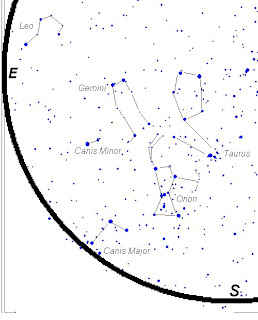
.....Tonight (Sunday, December 13th) is the peak of the Geminind meteor shower. This is one of the best meteor showers of this year (if it is not currently snowing where you are - sigh). The Geminid meteor shower comes from a trail of dust in the orbit of 3200 Phaeton.
.....This is unusual in that most meteor showers are due to the Earth crossing that path of a comet, and hitting (at about 60+ kilometers per second) the little pieces of dust that once, on some long previous pass, boiled off of the comet and helped reflect sunlight, resulting in the comet's bright tail. Phaeton is classified as an asteroid, not a comet, but it could simply be a comet so darn old that all of the ice (the shiny bit of a comet) has long since been evaporated by the Sun.
.....Looking for meteor showers is easy, as observational astronomy gets. Just go outside and get comfortable, and look in the general direction of east. Meteor showers have names due to the fact that they are all on pretty much the same orbit, so as the Earth moves through their path, the hits of the particles on the Earth (which heats them several hundred degrees in a few seconds as they burn up in the Earth's atmosphere) all seem to come from the same general part of the sky. In this case, the central point for these meteors is the general area of the constellation Gemini.
.....In the image that accompanies this entry, I have provided a view of the eastern sky from the northern US at about ten o'clock at night, to help you find Gemini. (Hint: start by looking for Orion the Hunter, one of three constellations that actually looks like what it's named after -- a big guy with a belt, sword, club and shield. These are also some of the brightest stars in the winter sky. We're going to come back to Orion soon for my series "So you just got a telescope", for anyone getting a telescope as a holiday present.)
.....The Geminid meteor shower has three things going for this year. First, the Moon is almost new, so the Moon will be providing absolutely no light to interfere with the meteor shower. Second, the Geminid shower has been very strong in recent years. One could expect to see up to 120 meteors per hour in perfect conditions, which, unfortunately includes being far, far away from city lights. Thirdly, the Geminid shower is one that is almost as strong before midnight as it is after midnight, so a little evening viewing should give you a view of some meteors. If the weather is clear, wrap yourself up warmly and give yourself a view!
.....(The peak is expected to be at about 11:10 PM CST.)
